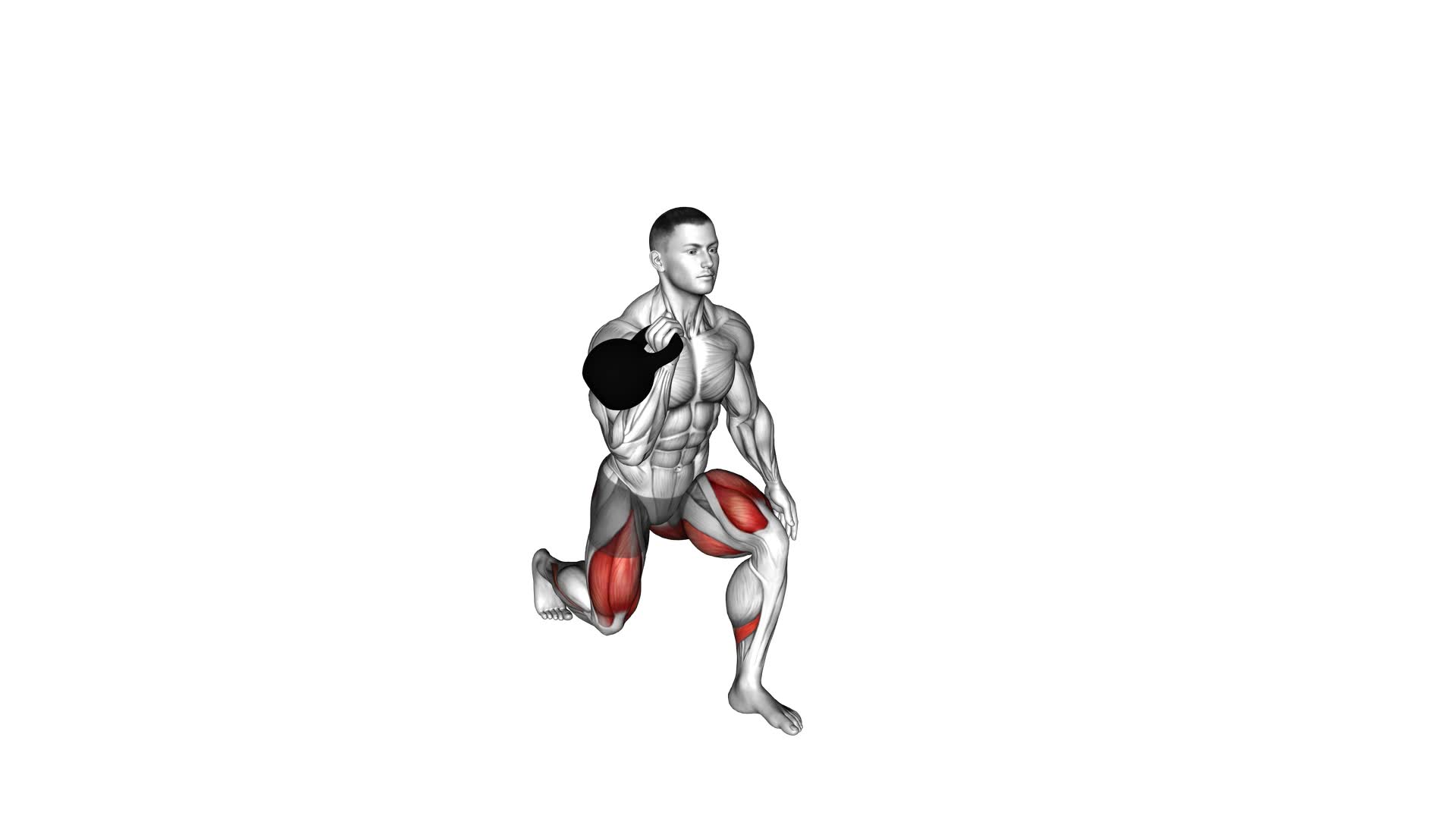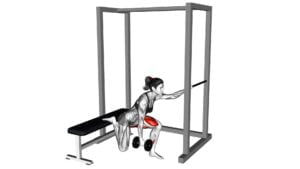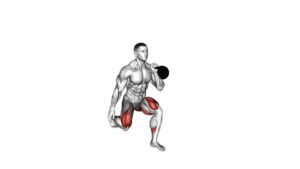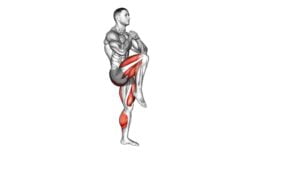Kettlebell Contralateral Reverse Lunge (male) – Video Exercise Guide & Tips

Are you looking to take your workout routine to the next level?
Watch This Exercise Video
Then the Kettlebell Contralateral Reverse Lunge is the exercise for you. In this video exercise guide, we'll show you the proper form and technique to maximize your results.
Avoid common mistakes and discover variations for advanced users.
Plus, we'll provide safety tips and a sample workout routine to help you incorporate this powerful exercise into your fitness regimen.
Get ready to challenge yourself and achieve your fitness goals.
Key Takeaways
- Targets multiple muscles, including quadriceps, glutes, hamstrings, and calves
- Activates core muscles for stabilization
- Improves lower body strength and stability
- Enhances balance and coordination
Benefits of the Kettlebell Contralateral Reverse Lunge
Discover the numerous benefits you can experience from incorporating the Kettlebell Contralateral Reverse Lunge into your fitness routine. This exercise targets multiple muscles, making it an effective addition to a full body workout routine.
The Kettlebell Contralateral Reverse Lunge primarily targets the quadriceps, glutes, hamstrings, and calves. By lunging backward with one leg while holding a kettlebell in the opposite hand, you engage these muscles in a challenging and dynamic way. This exercise also activates your core muscles, as they work to stabilize your body during the movement.
Incorporating the Kettlebell Contralateral Reverse Lunge into a full body workout routine can provide several benefits. First, it helps improve lower body strength and stability, enhancing your overall athletic performance. Second, it can help increase muscle definition and tone in your legs, giving you a more sculpted appearance. Additionally, this exercise can improve balance and coordination, as each lunge requires precise control and coordination between your upper and lower body.
To maximize the benefits of the Kettlebell Contralateral Reverse Lunge, you can incorporate it into a circuit or superset with other exercises that target different muscle groups. This way, you can create a well-rounded full body workout routine that challenges your entire body and helps you achieve your fitness goals.
Proper Form and Technique for the Exercise
To perform the Kettlebell Contralateral Reverse Lunge correctly, you need to maintain proper form and technique throughout the exercise. One common misconception is that the lunge should be performed quickly. However, it's important to remember that control and stability are key.
Start by holding a kettlebell in one hand, allowing it to hang by your side. Stand tall with your feet shoulder-width apart. Take a step backward with your opposite foot, keeping your core engaged and your chest up. As you lower your back knee towards the ground, make sure your front knee stays directly above your ankle.
Push through your front heel to return to the starting position. Repeat on the other side. This exercise primarily targets the quadriceps, hamstrings, glutes, and core. Additionally, it activates the muscles in your upper back, shoulders, and arms as you stabilize the kettlebell.
Common Mistakes to Avoid
To avoid common mistakes while performing the Kettlebell Contralateral Reverse Lunge, make sure that you don't rush the exercise and focus on maintaining control and stability throughout.
One common mistake is rushing through the movement without proper form. It's important to take your time and perform the exercise with proper technique.
Another mistake to avoid isn't engaging your core muscles. Your core plays a crucial role in maintaining stability and balance during the exercise, so be sure to activate your core throughout the movement.
Additionally, avoid leaning too far forward or backward during the lunge. This can put unnecessary strain on your knees and lower back. Instead, keep your torso upright and maintain a neutral spine.
Lastly, be mindful of your foot placement. Make sure your front foot is firmly planted on the ground and your back foot is positioned correctly for balance.
Variations and Progressions for Advanced Users
For advanced users, there are several variations and progressions to challenge your strength and coordination in the Kettlebell Contralateral Reverse Lunge.
One advanced technique you can try is the Kettlebell Contralateral Reverse Lunge with an Overhead Press. Start by holding a kettlebell in one hand at shoulder level while performing the reverse lunge. As you step back, press the kettlebell overhead, engaging your shoulder muscles and core. This variation not only increases the difficulty of the exercise but also adds an upper body component for improved muscle activation and coordination.
Another advanced progression is the Kettlebell Contralateral Reverse Lunge with a High Pull. Begin by holding a kettlebell in one hand at waist level. As you step back into the reverse lunge, pull the kettlebell up towards your chest, engaging your back muscles and challenging your balance. This variation enhances both upper and lower body strength, as well as core stability.
Incorporating these advanced techniques into your Kettlebell Contralateral Reverse Lunge routine will help you take your workout to the next level. Remember to start with lighter weights and focus on proper form before progressing to heavier loads.
Now that you know some advanced variations, let's move on to the next section about safety tips and precautions to ensure you can perform the exercise safely and effectively.
Safety Tips and Precautions
Ensure proper form and minimize the risk of injury by following these safety tips and precautions for the Kettlebell Contralateral Reverse Lunge exercise.
Preventing injuries should always be a top priority during any workout routine. To start, it's essential to warm up your body properly before attempting this exercise. Engaging in warm-up exercises such as jogging, jumping jacks, or dynamic stretches will prepare your muscles for the upcoming movement and reduce the chances of strains or pulls.
When performing the Kettlebell Contralateral Reverse Lunge, remember to maintain a stable core and keep your back straight throughout the movement. This will help prevent unnecessary stress on your spine. Additionally, ensure that your knees are tracking in line with your toes, and avoid letting them collapse inward.
It's crucial to start with a lighter weight kettlebell and gradually increase the load as you become comfortable with the exercise.
Lastly, listen to your body and stop if you experience any pain or discomfort.
Sample Workout Routine Incorporating the Kettlebell Contralateral Reverse Lunge
Now that you understand the benefits of lunges and the exercise modifications for beginners, it's time to incorporate the kettlebell contralateral reverse lunge into your workout routine.
This exercise is a great way to engage your lower body muscles and improve balance and stability. By adding it to your routine, you can challenge yourself and continue to progress towards your fitness goals.
Benefits of Lunges
To maximize the benefits of lunges in your workout routine, incorporate the kettlebell contralateral reverse lunge. This variation of lunges not only targets your lower body but also engages your core and improves stability. Here are the benefits of lunges and a sample workout routine incorporating the kettlebell contralateral reverse lunge:
- Lunges for Weight Loss:
- Lunges are a compound exercise that engages multiple muscle groups, helping you burn more calories and aiding in weight loss.
- They increase your heart rate and promote cardiovascular endurance, further supporting weight loss goals.
- Different Types of Lunges:
- Reverse lunges target the glutes, hamstrings, and quadriceps while also improving balance and coordination.
- Contralateral lunges, like the kettlebell contralateral reverse lunge, challenge your core and promote stability by requiring you to move in a cross-body pattern.
Incorporating these lunges into your workout routine can help you achieve your weight loss goals while improving strength, stability, and overall fitness. Now let's explore modifications for beginners to ensure proper form and prevent injury.
Exercise Modifications for Beginners
To properly modify the kettlebell contralateral reverse lunge for beginners, start with a lighter kettlebell weight. This will help you focus on your form and build strength gradually.
It's important to maintain proper posture throughout the exercise, keeping your chest up and shoulders back. If you find it challenging to balance with the kettlebell, you can also use a chair or wall for support.
Another modification is to decrease the range of motion by taking smaller steps during the lunge. As you become more comfortable and confident, you can gradually increase the weight and range of motion.
Remember to listen to your body and only progress when you feel ready. These exercise modifications and beginner tips will help you safely and effectively incorporate the kettlebell contralateral reverse lunge into your workout routine.
Frequently Asked Questions
How Many Calories Can Be Burned by Performing the Kettlebell Contralateral Reverse Lunge?
When performing the kettlebell contralateral reverse lunge, you can burn calories effectively. The number of calories burned depends on various factors such as your weight, intensity, and duration of the exercise.
Incorporating kettlebell exercises into your workout routine can be a great way to burn calories and build strength. If you don't have access to kettlebells, you can try using dumbbells or even bodyweight exercises as alternative equipment options.
Can the Kettlebell Contralateral Reverse Lunge Help Improve Balance and Coordination?
Improving balance and coordination are key benefits of kettlebell training.
By incorporating exercises like the kettlebell contralateral reverse lunge, you can enhance your stability and control.
This movement specifically targets the muscles responsible for balance, such as the glutes, quads, and core.
By regularly practicing this exercise, you can strengthen these muscles and improve your overall coordination.
What Muscles Does the Kettlebell Contralateral Reverse Lunge Primarily Target?
The kettlebell contralateral reverse lunge primarily targets several key muscles in your lower body. By incorporating this exercise into your routine, you can strengthen and tone your glutes, quadriceps, hamstrings, and calves.
Additionally, it helps improve your balance and stability, making it a beneficial exercise for athletes and those looking to enhance their overall lower body strength.
There are also variations of lunges that can target different muscle groups, allowing for a well-rounded lower body workout.
Is It Necessary to Use a Kettlebell for the Contralateral Reverse Lunge, or Can Other Weights Be Used?
Using alternatives to a kettlebell for the contralateral reverse lunge is possible. However, the benefits of using a kettlebell are worth considering.
It adds resistance to the exercise, helping to increase strength and improve stability. The weight distribution challenges your core and promotes better balance.
While other weights like dumbbells or a barbell can be used, a kettlebell offers unique advantages that can enhance your workout.
Can the Kettlebell Contralateral Reverse Lunge Be Performed by Individuals With Knee or Hip Injuries?
Yes, the kettlebell contralateral reverse lunge can be modified for individuals with knee or hip injuries. To adapt the exercise, you can decrease the range of motion or use a lighter kettlebell.
It's important to listen to your body and not push yourself too hard. If you're a beginner, you can start by practicing the movement without any weights or with a lighter weight.
As always, consult with a professional trainer or healthcare provider for personalized advice.
Conclusion
The kettlebell contralateral reverse lunge is an effective exercise for improving strength, stability, and balance. By incorporating a kettlebell and performing lunges in a reverse motion, you engage multiple muscle groups and challenge your body in a new way.
Maintaining proper form and avoiding common mistakes are essential to maximizing the benefits of this exercise. Advanced users can explore variations and progressions to further challenge themselves.
Remember to prioritize safety and consult with a fitness professional before attempting new exercises.

Author
Years ago, the spark of my life’s passion ignited in my mind the moment I stepped into the local gym for the first time. The inaugural bead of perspiration, the initial endeavor, the very first surge of endorphins, and a sense of pride that washed over me post-workout marked the beginning of my deep-seated interest in strength sports, fitness, and sports nutrition. This very curiosity blossomed rapidly into a profound fascination, propelling me to earn a Master’s degree in Physical Education from the Academy of Physical Education in Krakow, followed by a Sports Manager diploma from the Jagiellonian University. My journey of growth led me to gain more specialized qualifications, such as being a certified personal trainer with a focus on sports dietetics, a lifeguard, and an instructor for wellness and corrective gymnastics. Theoretical knowledge paired seamlessly with practical experience, reinforcing my belief that the transformation of individuals under my guidance was also a reflection of my personal growth. This belief holds true even today. Each day, I strive to push the boundaries and explore new realms. These realms gently elevate me to greater heights. The unique combination of passion for my field and the continuous quest for growth fuels my drive to break new ground.







